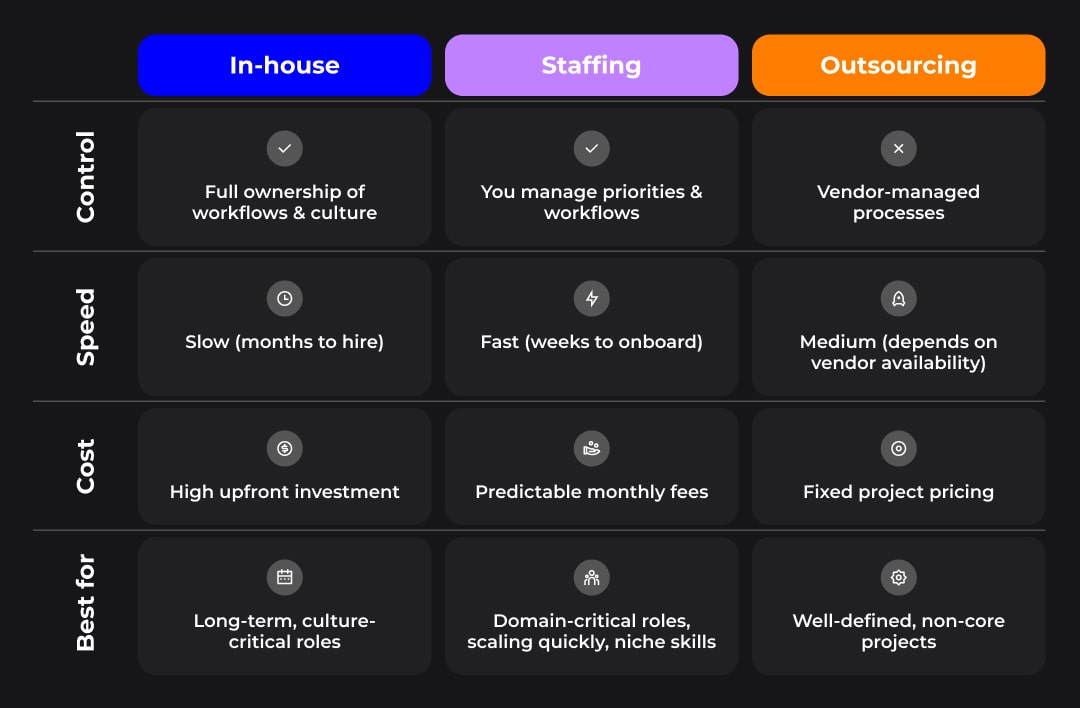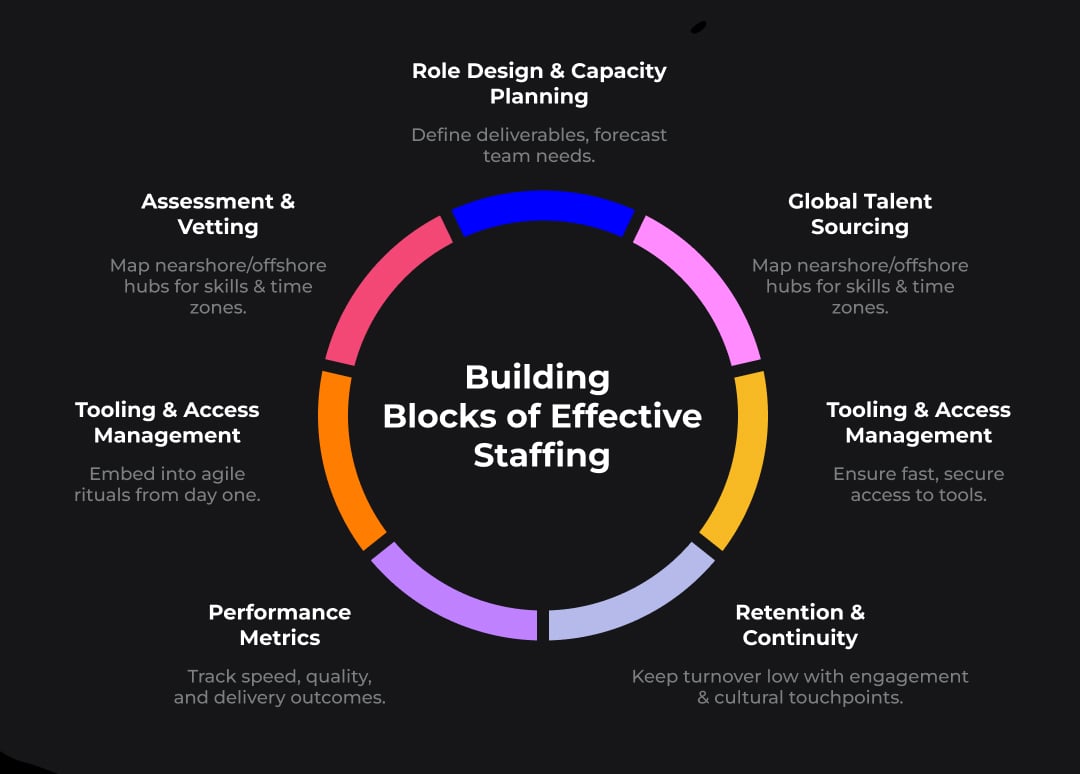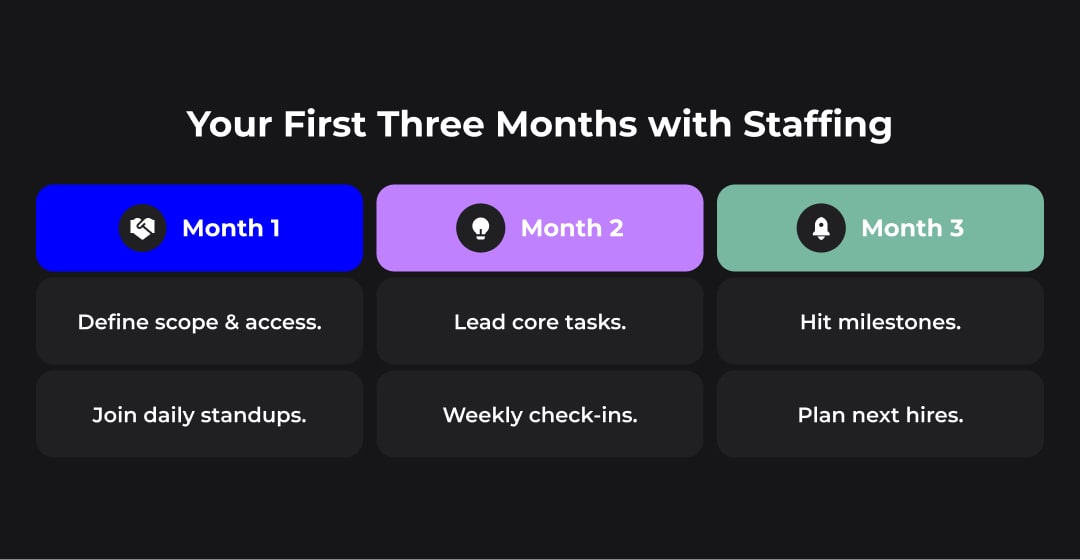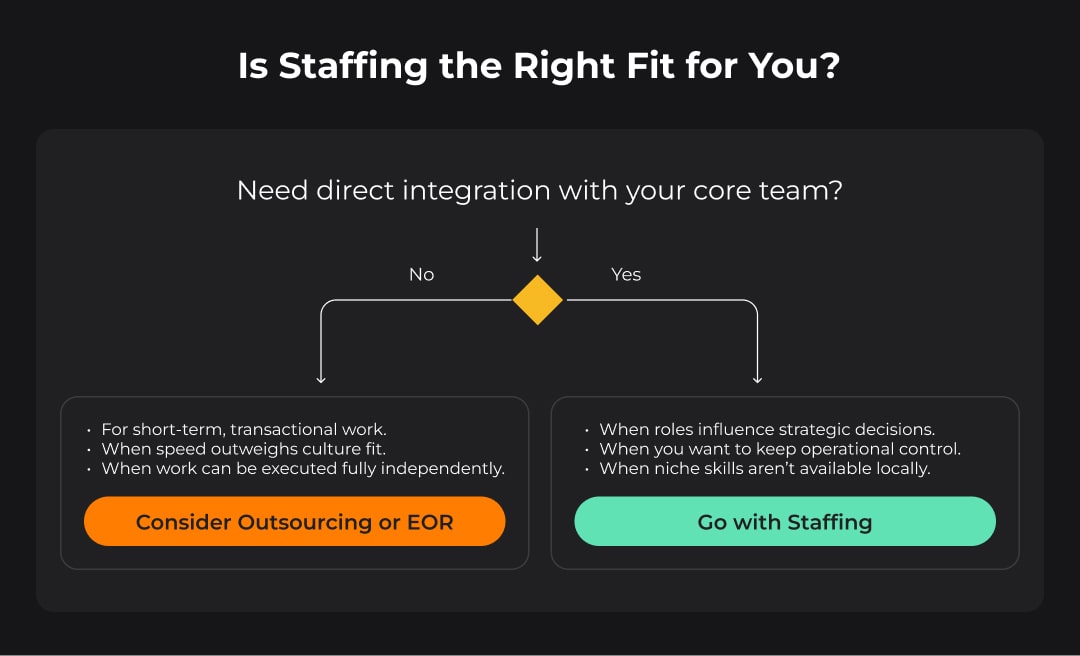- Why Staffing Is Surging in 2025 And Who It Serves
- Choosing the Right Talent Model: Build vs. Staff vs. Outsource
- 7 Building Blocks of Effective Staffing (Our Operating Model)
- Why Staffing Works And How Our Approach Delivers More
- Where to Find the Skills You Need in 2025
- Implementation Playbook: Your First Three Months with Staffing
- When Staffing Is Not the Right Answer
- From Vacancy to Velocity
- FAQ
Finding the right people has never been tougher. In 2025, Manpower Group states that 74% of employers worldwide say they struggle to fill roles. In the tech sector, that gap feels wider still. While projects’ deadlines burn, the median time-to-hire for tech roles hovers around 48 days. For small and mid-sized companies, this may feel like an eternity in product cycles.
So, what do you do with this fierce competition and tight budgets? You look for a hiring model that bends with your needs. That’s where a modern staffing process proves its worth.
In our work, it’s often the companies expanding into new markets that turn to staffing first. They can’t afford to dilute the culture they’ve built at headquarters, yet they need people on the ground who can plug in and start delivering from day one. One client came to us with exactly that challenge. The solution? We sourced the right talent abroad, handled every compliance detail, and made sure those new team members were fully woven into their product workflow. The result was extra capacity without losing the very DNA that made their business stand out.
So, What Is Staffing?
By staffing business definition, it is a talent engagement model where you directly manage professionals provided by a staffing partner. Unlike outsourcing, you keep operational control, integrate talent into your in-house workflows, and set the priorities, while the partner handles recruiting, vetting, contracts, payroll, and HR support.
Why Staffing Is Surging in 2025 And Who It Serves
Staffing’s rise in 2025 is the result of long-brewing pressures finally reaching a boiling point. In many tech-driven sectors, the speed of innovation has outpaced traditional hiring models. Companies aren’t just competing with their direct rivals for talents. They’re up against every organization chasing the same rare skill sets. Add in the shift toward distributed teams, the need for niche expertise on-demand, and tighter hiring budgets, and you have a perfect storm that’s forcing leaders to rethink how they build capacity.
IT projects continue to add on across SaaS, AI, fintech, healthtech, e-commerce, and logistics tech areas. We see the strongest hiring appetite among small and mid-sized companies that can move quickly to capture market share. Many are also embracing remote-first and distributed models, an environment where the process of staffing shines because it lets businesses tap into global talent pools without losing operational control.
The key difference, you ask? Traditional staffing often stops at filling a vacancy, with talent working under the provider’s oversight and limited integration into the client’s culture. In contrast, our approach embeds specialists directly into your team, where you set the priorities, workflows, and strategy while we handle recruitment, contracts, payroll, and retention. The result is a team that feels truly yours, without the overhead of running an internal HR department.
Who Staffing Serves Best
While there are many types of staffing, not every business feels the same urgency or gets the same value from adopting it. The sweet spot tends to be founders and CEOs who need capacity now but don’t want to build a large HR function. These are leaders who want to directly manage their team, align talent with their strategy, and still have a partner covering all the heavy lifting behind the scenes.
At Outstaff Your Team, we’ve seen this play out repeatedly. Take Digital Original, a blockchain-based innovator in the tokenization of fine art. They needed an MVP fast enough to seize a market window, without the burden of building internal HR. In less than six months, we filled 18 specialist roles and set up all HR operations helping them launch in half the expected time. This approach brought us the Golden Stevie Awards 2025 for building a fully operational in-house product team in 6 months with a rare talent.
Staffing works best for businesses that:
Need to scale tech teams quickly without adding internal HR headcount
Require direct control over team priorities and workflows
Want flexibility to adjust team size and roles as the project evolves
Seek niche or cross-border talent that’s hard to find locally
Prefer a partner who manages HR, contracts, and retention while they focus on core growth.
Ready to turn open roles into productive seats in weeks, not months? Our staffing guide isn’t just theory, we do it every day.
Get my quote
The right staffing model doesn’t just fill roles. It buys back the founder’s time when it’s needed most.
Choosing the Right Talent Model: Build vs. Staff vs. Outsource

In 2025, leaders in fast-moving tech environments are asking how they should expand capacity. The answer often comes down to choosing between three dominant models: building in-house, staffing, or outsourcing. Each comes with trade-offs in control, speed, cost, and long-term flexibility.
McKinsey’s 2025 HR Monitor Survey reveals that talent acquisition is becoming increasingly complex, with offer acceptance rates averaging just 56% across the countries studied, 18% of new hires leaving during probation, and overall hiring success in Europe at only 46%.
In such a climate, models like staffing offer a faster, more strategic route to secure and retain talent without the long lead times and attrition risks of traditional hiring.
Comparative View: Build vs. Staff vs. Outsource
Model
Control over workflows
Speed to start
Cost predictability
Best For
Risks
Build
In-House
Full control
Slow (months to hire)
Variable (salaries, benefits, overhead)
Long-term, core culture roles
High upfront cost, slower ramp-up
Staffing
High: direct team management
Fast (weeks)
Predictable monthly fees
Domain-critical roles, scaling quickly, niche talent
Needs strong internal leadership to guide priorities
Outsourcing
Low: vendor-managed
Medium
Fixed project-based pricing
Well-defined, non-core projects
Less control, risk of misalignment with strategy
When Staffing Wins: The Strategic Sweet Spot
Staffing is something more than a middle ground between hiring and outsourcing. It's a precision tool when you need speed without giving up control. It works best when:
The role demands direct communication with your core team.
Collaboration is strategic, not just transactional.
The skill set is rare locally, but can be found in other regions.
You need flexible staffing that can scale up or down without severance or rehiring delays
One of our clients was searching for a senior Full Stack Engineer with DevOps expertise, someone who could also step into a fractional CTO role. The challenge? The hire had to be deeply embedded in the business, influencing both infrastructure and strategic decisions. Outsourcing was out of the question: too much was at stake in aligning tech architecture with business direction. Within weeks, our IT team staffing approach delivered the right candidate on a flexible schedule. The result? Development costs halved after infrastructure optimization, and the same expertise would have cost 4–5x more locally.
This was a clear example of staffing efficiency, matching the right expertise to the client’s needs in a way that accelerated delivery, optimized infrastructure, and kept costs well below local market rates.
Once the right talent model is clear, the question becomes: how do you make staffing work to its full potential? Choosing staffing over building in-house or outsourcing is just the first step. The real impact comes from the way it’s executed. That’s where a structured operating model transforms a simple hire into a long-term business advantage.
7 Building Blocks of Effective Staffing (Our Operating Model)

What makes the staffing process work so well for tech SMEs in 2025? It’s not luck. It’s structure — a deliberate sequence of actions that turn uncertainty into predictable results. Think of it like building a bridge: every beam and cable has a role, and if one is missing, the whole structure wobbles.
So, what activities are included in the staffing process? From our experience, seven pillars keep the system steady, ensuring businesses don’t just find talent, but keep it working at full potential.
1. Role Design & Capacity Planning
It’s tempting to chase the “unicorn hire”. But this often leads to frustration and churn. We work with clients to scope roles clearly, define deliverables, and forecast team capacity for six to twelve months. This clarity saves weeks in the hiring and staffing phase and avoids mismatched expectations down the line.
When you rush staffing decisions without clarifying the day-to-day reality of the role, you risk early churn and wasted budget. That’s why, in our staffing process, we go beyond the job title and scope responsibilities in detail before sourcing.
This was a clear example of staffing efficiency, matching the right expertise to the client’s needs in a way that accelerated delivery, optimized infrastructure, and kept costs well below local market rates.
This principle is just as true in staffing as it is in hiring, except the stakes are higher. You usually want the talent to be productive in days, not months.
2. Global Talent Sourcing
Location is no longer a barrier, but it’s not a free-for-all either. We map nearshore and offshore hubs with strong talent pools in target technologies, ensuring time-zone compatibility and cultural fit. A fintech client once said it felt like we had “read their mind” when we presented a shortlist of candidates who could hit the ground running from day one.
3. Assessment & Vetting
Hard skills are table stakes; what wins is alignment with the client’s way of working. One of our recent NDA clients spent three months unsuccessfully searching for an AI developer in Mexico. We expanded the search across LATAM, vetted for technical mastery and communication skills, and delivered the right match. The result? Their development schedule got back on track without budget overruns, which is a clear case in the pros of staffing agencies.
The number one cause of voluntary turnover is a lack of person-environment fit. Use personality questionnaires as a minimum screen, as interviews alone won’t catch the signals.
In our experience, this extra step in the staffing process is what keeps retention rates well above industry norms and ensures clients don’t have to start from scratch mid-project.
4. Integration into Product Teams
Dropping a new hire into a team without support is like tossing someone into the deep end without a life vest. We ensure staffing success by embedding talent into the client’s agile rituals, code ownership structures, and decision-making channels from day one. That means faster ramp-up and less disruption.
5. Tooling & Access Management
The best collaboration can be derailed by messy tool setups or slow access approvals. We standardize these processes, aligning with the client’s security protocols, while making sure new team members can contribute from their first sprint.
6. Performance Metrics
We track lead time for changes, deployment frequency, and change fail rates. These components are the pulse of the project. Monitoring them ensures the staffing model isn’t just filling seats, but actively improving delivery outcomes.
7. Retention & Continuity
Teams lose momentum when knowledge walks out the door. Our retention plans, regular check-ins, and embedded cultural touchpoints keep turnover low. One e-commerce client told us they “forgot” their team was technically staffed because it felt so much like an in-house crew. That’s when you know the bridge is holding steady.
Need niche skills without the hiring delays? The process of staffing we use gets you vetted talent fast, integrated into your workflow.
Find my talent
Why Staffing Works And How Our Approach Delivers More
One of the most common questions you may ask is: “Why choose staffing over other hiring models?” In short, when done right, staffing delivers flexibility and control, which is a rare combination in today’s unpredictable hiring landscape.
Think of it as fitting your business with a high-performance gearbox. You still steer the strategy, but you can switch speeds instantly without grinding the engine. That’s the power of the process of staffing when applied to complex, fast-moving tech environments.
Our approach is designed around key differentiators that go beyond what are staffing agencies in the traditional sense:
Operational control stays with you. You define workflows, priorities, and cultural fit.
Speed & flexibility. Start part-time, scale up or down without severance headaches.
Full-cycle coverage. From sourcing to contracts, payroll, and HR operations.
Expanded reach. Access talent from specialist hubs with stronger ecosystems than your local market.
For instance, one client was expanding into new international markets, but quickly ran into a wall. Their local recruitment channels weren’t delivering qualified candidates, competition for niche skills was fierce, and every unfilled role meant delays in their launch plans. They also knew that building an internal HR department for this push would eat up a large portion of the budget.
Through our flexible staffing model, we sourced the right talent from specialist hubs abroad, handled contracts and compliance, and ensured these new hires were fully integrated into the client’s culture. The leadership retained direct oversight of priorities and workflows while we took care of HR operations end-to-end. Compared to building an in-house team from scratch, this approach freed up months of hiring time and preserved more than 40% of the projected HR budget. This is a clear example of IT staffing process efficiency.
The IT staffing trends we’re seeing in 2025 make this approach especially valuable for domain-critical work, where strategic alignment, cross-border expertise, and budget control matter as much as speed.
Where to Find the Skills You Need in 2025
It’s a question many leaders ask: does the model you choose really affect how and where you find talent? Absolutely. In 2025, the what is staffing industry conversation has shifted from “can we fill the role?” to “can we find the right skills, fast, and without losing cultural alignment?”
The latest ASA Staffing Index Monthly Report shows just how dynamic this space has become. Staffing employment rebounded sharply after the July slowdown, with new starts up 22.3% in a single week. More than six in 10 staffing companies reported growth in new assignments. This is a sign that, even in a cautious labor market, the demand for temporary and contract workers remains strong. This resilience underscores one of staffing’s core advantages: the ability to tap into active, pre-vetted talent pools on short notice.
Comparing Talent Sourcing Across Models
Criteria
Staffing
Outsourcing
Traditional Recruiting
Speed to Find Talent
High — agencies maintain ready pools, enabling placements within days or weeks.
Moderate — vendor may need to reassign existing staff or recruit from scratch.
Low to Moderate — depends on internal HR bandwidth; often 1–3 months.
Global Reach
Strong — access to multiple markets via established sourcing hubs.
Limited to vendor’s delivery locations.
Variable — often limited to local/national reach unless specialized recruiters are engaged.
Skill Specialization
High — can target niche roles like AI engineers, blockchain developers, or cloud architects.
Medium — talent aligned to vendor’s core service offering.
Variable — depends on recruiter expertise in tech verticals.
Cultural Alignment
Strong — client manages day-to-day; integration into existing team culture.
Weak to Medium — vendor team follows its own workflows and culture.
Strong — direct hire joins the company fully.
Flexibility to Scale
High — add or reduce team size without severance costs.
Medium — contractual limitations may apply.
Low — reducing headcount triggers redundancy or severance obligations.
Cost Efficiency
High — avoids long hiring cycles and reduces HR overhead.
Medium — bundled vendor pricing may include unused capacity.
Low to Medium — higher ongoing costs for benefits, HR ops, and attrition replacement.
Choosing the right hub or sourcing path is about staffing efficiency in context. For example, a startup came to us after months of hiring and staffing internally had stalled. By switching to a staffing model, they accessed nearshore locations, quickly filled their critical roles, while preserving their own culture.
In short, your staffing guide to 2025 talent sourcing boils down to three factors: the model’s inherent speed, its reach into niche ecosystems, and its ability to align skills with your culture and budget. Get those right, and you’re building a team that can run at the pace of your ambition.
Implementation Playbook: Your First Three Months with Staffing

When a business opts for staffing, the first quarter is setting the stage for long-term success. From our extensive experience working with clients across industries and continents, we know that those first three months can be the make-or-break period for team cohesion, speed, and results. Think of it as planting a tree: the early care you give determines how strong and productive it will grow.
Month 1: Alignment, Access & Early Integration
How quickly can staffing teams start delivering? The answer: faster than you think, provided the right foundations are in place.
From day one, you’re setting a specialist up to dive directly into your workflows, culture, and goals.
Clarify scope and priorities. Define responsibilities to prevent “unicorn hire” traps.
Secure access fast. Tools, code repositories, communication platforms, and permissions must be ready to prevent lost days.
Embed in rituals. Daily standups, sprint planning, retros; early participation accelerates cultural fit.
Time zone mapping. Align overlaps for real-time problem-solving.
The types of staffing that succeed the quickest are those with clear expectations and immediate integration into the decision-making flow.
Month 2: Collaborative Ownership
By the second month, you’re shifting from a “watch and learn” phase to genuine co-ownership. It’s the moment when staffing professionals stop asking where the tools are and start suggesting better ones.
Shadow ➜ Pair ➜ Lead. Gradually hand over end-to-end responsibility for core deliverables.
Set and track KPIs. Output quality, delivery speed, and communication responsiveness.
Maintain structured feedback. Weekly performance check-ins prevent small issues from snowballing.
Encourage proactive contribution. Tap into global perspectives; remote hires often bring fresh problem-solving approaches that in-house teams miss.
In our work, we’ve seen this transition cut onboarding time in half compared to traditional hires. This is a key advantage of the IT staffing process.
Month 3: Deliver Value & Prepare to Scale
By the third month, if the staffing process has been executed well, ROI will become visible in your KPIs.
Hit first milestones. Product features are released, QA cycles completed, sales funnels are operational.
Run a 360° review. Assess skill match, cultural fit, and productivity alignment with long-term goals.
Plan for scaling. Identify which roles to add or adjust based on growth plans.
Preserve culture while expanding. Especially critical when scaling abroad.
Companies that reach this stage with staffing describe it as “having a high-performance engine dropped into their existing vehicle”. They keep the steering wheel, but the horsepower multiplies.
According to Workwell Global’s 2025 Staffing Industry Trends, the US staffing market with over $188 billion USD in value is projected to grow by 5% in 2025. Today, it's highly driven by IT and healthcare demand. In Europe, Southern markets like Spain and Italy are outperforming the regional average, with Spain forecasted to grow by 6% this year. These trends show that businesses in both mature and emerging markets are leaning into agile staffing solutions to meet hiring challenges. They make the first three months of the staffing journey critical for establishing long-term success.
When Staffing Is Not the Right Answer

Staffing delivers agility and control, but it’s not a one-size-fits-all solution. In some cases, outsourcing, or other models can offer a better fit.
Consider alternatives when:
Work is fully transactional and doesn’t require direct integration with your core team.
Speed outweighs control, and you need a complete, ready-made team to start tomorrow.
Cost is the only driver and the lowest possible rate is the priority over culture fit.
Scope is fixed and can be executed independently without ongoing collaboration.
You need local legal presence or compliance in countries where you have no entity.
Project is short-term and doesn’t justify embedding long-term talent.
If the role doesn’t influence strategic decisions, rarely interacts with internal stakeholders, or has deliverables that can be fully outsourced, staffing may not be the most efficient route. Pivot early to avoid sunk costs.
From Vacancy to Velocity
When deadlines slip and qualified candidates ghost interviews, growth stalls. That’s the daily grind many managers face: too many resumes, not enough fit, and a clock that won’t stop. The point of our guide has been simple: if you need capacity fast, and you want to keep your hands on the wheel, staffing is the lever. Done right, it compresses time-to-impact, expands your reach to scarce skills, and preserves the culture you’ve worked hard to build.
The playbook is repeatable: define the role precisely, source globally, vet for fit (not just skills), integrate into your rituals, and measure delivery. That’s how teams go from “open position” to “closed vacancy” without burning budget or burning out. And when the model doesn’t fit, you now know when to reach for recruiting or EOR instead.
Wondering if staffing will work for your business? Our specialists can talk through your goals and map out the first steps together.
Contact us
FAQ
What is staffing in business?
Staffing in business is the process of sourcing, vetting, and placing the right talent. Specialists are often placed on a flexible or project basis to meet specific operational needs without building a large in-house HR function. It’s a way to quickly access skills, maintain control, and scale teams efficiently.
What are the types of staffing?
The main types of staffing include temporary staffing, contract staffing, project-based staffing, and dedicated team staffing. Each model varies in duration, cost, and integration level, allowing businesses to match talent strategy with project scope and budget.
How can I improve staffing efficiency?
You can improve staffing efficiency by clearly defining roles, using global talent pools, applying culture-fit assessments, and partnering with a reputable staffing agency that manages HR, payroll, and compliance while you focus on core growth.
What is the difference between hiring and staffing?
Hiring usually refers to building permanent in-house roles, managed fully by your HR team. Staffing provides vetted professionals through an agency, giving you faster access to skills, lower risk, and greater scalability.
Ann Kuss is the CEO at Outstaff Your Team. After 11 years of expertise in building remote tech teams for startup unicorns and global tech brands, Ann decided to lead a new venture aiming to reinvent the way international tech teams scale. Throughout her career, Ann hired specialists for countless tech positions from more than 17 countries on all major continents. Ann graduated from Kyiv-Mohyla business school, is an MIM Kyiv alumna, and regularly takes part in mentorship programs for junior tech talents. Ann actively promotes knowledge sharing and curates Outstaff Your Team blog strategy, preferring topics that solve practical needs of IT leaders. She believes that structuring business flows (including hiring) is a well-planned journey with predictable and successful outcome.







